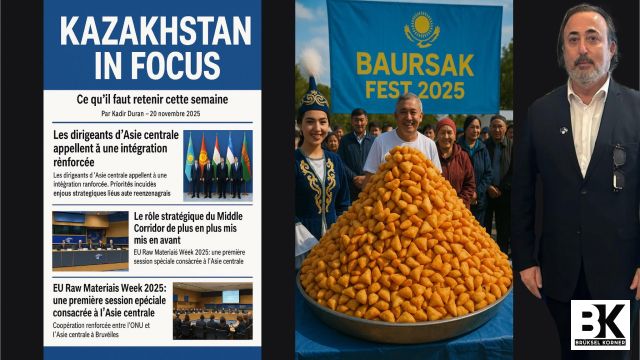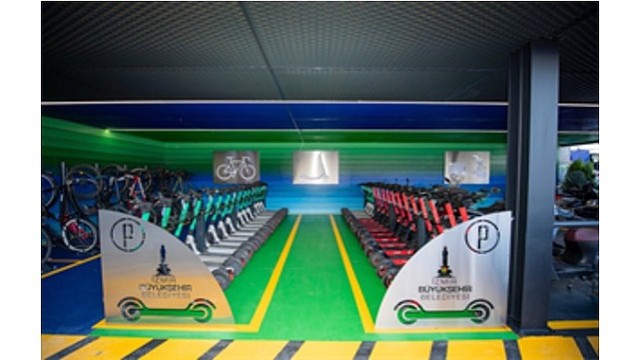The European Parliament hosted a landmark roundtable titled “Strengthening EU–Kazakhstan Connectivity

Photo credit: Derya Soysal
On 19 November 2025, the European Parliament hosted a landmark roundtable titled “Strengthening EU–Kazakhstan Connectivity: Perspectives and Strategic Potential of the Middle Corridor.” Far from being a routine policy discussion, the event showcased the rapidly rising importance of the Trans-Caspian International Transport Route—commonly known as the Middle Corridor—as a pillar of Europe’s future connectivity, strategic autonomy, and geopolitical resilience.
Gathering Members of the European Parliament, diplomats, institutional actors, and experts, the roundtable illustrated not only how much the Middle Corridor has evolved but also how deeply it is embedded in Europe’s long-term vision for security, trade diversification, and green transition.
What emerged is a clear message: Kazakhstan has become indispensable to Europe’s future connectivity architecture.
- MEP Ilhan Kyuchyuk
Opening the roundtable, MEP Ilhan Kyuchyuk, Chair of the Committee on Legal Affairs, set the tone by framing the Middle Corridor not simply as logistics infrastructure, but as a strategic symbol. In his words, the initiative embodies “resilience, sustainability, and strategic autonomy.”
His argument rested on several pillars:
Eurasia as a Single Strategic Space
Kyuchyuk highlighted that Europe and Asia cannot be conceptualised as isolated geopolitical spheres. The Middle Corridor demonstrates this reality: the “Eurasia” concept is a continuum, and connectivity from Central Asia through the Caspian and the South Caucasus to Europe represents a single integrated strategic arena.
This framing carries profound implications:
- - Europe’s geopolitical stability is linked to Central Asia’s stability.
- - Economic diversification is impossible without secure intercontinental corridors.
- - Connectivity defines power projection and autonomy.
Kyuchyuk underscored the importance of the EU–Kazakhstan Enhanced Partnership and Cooperation Agreement (EPCA), which spans 29 cooperation areas—trade, transport, energy, digitalization, sustainability, and more.
This agreement, he noted, has become the institutional backbone of the Middle Corridor’s rise. It shows that Europe and Kazakhstan have already built a structured framework for long-term cooperation—not an improvised response to geopolitical shocks.
The MEP’s core message was clear on the importance of the Middle Corridor:
“The Trans-Caspian route is much more than transport connectivity… it is a corridor of opportunity, a bridge of stability, and increasingly a symbol of strategic autonomy and shared prosperity.”
In this vision, the Middle Corridor is both economic and civilisational: a stabilising artery across a region where traditional East-West routes have become politically fraught.
Kyuchyuk did not shy away from challenges, listing critical issues that must be addressed:
- - Regulatory harmonisation
- - Infrastructure investments
- Cross-border coordination
- Logistics bottlenecks and high transport costs
- Environmental constraints - - The need for better governance and innovation
His emphasis on these challenges demonstrates maturity: Europe sees the Middle Corridor as indispensable, but not yet complete.
Finally, He also highlighted the importance of the 2022 Memorandum of Understanding on Raw Materials, Batteries, and Renewable Hydrogen, linking the corridor directly to Europe’s Green Deal.
This is more than symbolic:
- - Kazakhstan seeks to become a renewable hydrogen exporter.
- - Europe needs reliable suppliers for critical raw materials.
- - Green transport corridors will define sustainable logistics chains.
The future Middle Corridor, Kyuchyuk noted, will not simply move goods—it will support the green transition of two continents.
For the EU, the Middle Corridor relies not only on geography but on political reliability, and Kazakhstan provides both.
II. Ambassador Roman Vassilenko
Kazakhstan’s Ambassador to the EU, Roman Vassilenko, built upon Kyuchyuk’s framework by emphasising Kazakhstan’s active leadership in developing the corridor:
He reminded participants that Kazakhstan has long been a crossroads of civilizations and trade routes. Today, with the Middle Corridor, the country is prepared to play an even greater bridging role.
Massive Infrastructure Investments
Kazakhstan is not a passive partner; it is a principal architect of the corridor. Vassilenko highlighted:
- - large-scale railway modernization;
- expanded port capacities at Aktau and Kuryk; - - digitalized customs procedures;
- - alignment with global transport standards.
These efforts show Kazakhstan’s determination to become a land-linked nation, transforming its geography from a constraint into an asset.
The Ambassador emphasised that the Caspian ports of Aktau and Kuryk are becoming central to East-West flows. With South Caucasus partners—Azerbaijan, Georgia, Armenia, and Türkiye—Kazakhstan’s multivector diplomacy strengthens regional cohesion and enables efficient corridor development.
III. Aigul Kuspan
Aigul Kuspan, (Former Ambassador, Member of the Mazhilis of the Parliament of Kazakhstan) reminded the audience that 2025 marks the 10th anniversary of the EPCA, noting its significance for long-term cooperation.
She underscored the importance of Kazakhstan: (1) 85% of East–West overland cargo already passes through Kazakhstan.; (2) $35 billion invested in transport infrastructure, with $15 billion more planned by 2030; (3) 13 international corridors cross the country; (4) 1,700 km of new railways underway ; (5) Joint ventures such as Middle Corridor Multimodal Ltd enhance coordination with Azerbaijan and Georgia.
IV. DG INTPA Representative Fabienne Van Den Eede
Speaking on behalf of the European Commission, Fabienne Van Den Eede connected the Middle Corridor to Europe’s Global Gateway strategy.
She noted that EU is working on key strategic areas such as
1. Climate, water, and energy cooperation
2. Digital connectivity
3. Hard and soft infrastructure.
Talking about the Middle Corridor, Van Den Eede emphasised that railways, ports, and highways are indispensable.
Her intervention was particularly significant because she stressed that EU expertise is pivotal in developing soft connectivity—arguably the area with the fastest operational impact.
She also announced the upcoming Caspian Transport Corridor and Connectivity Forum, where the EU will further engage with regional partners.
V. MEP Sergey Lagodinsky
MEP Sergey Lagodinsky articulated one of the event’s most geopolitically significant arguments:
“We must diversify. We must avoid dependencies dominating our decisions.”
He pointed to Europe’s past reliance on the northern corridor through Russia—an arrangement rendered strategically untenable after the war in Ukraine.
Lagodinsky argued that the Middle Corridor is no longer optional:
- - It is essential for Europe’s capacity to act independently.
- It is a crucial counterbalance to geopolitical vulnerabilities. - He said that "Kazakhstan demonstrates that a landlocked country can become land-linked, overturning geographic determinism."
Lagodinsky’s comments reflect Europe’s new strategic realism: connectivity equals sovereignty.
VI. Samuel Doveri Vesterbye
Samuel Doveri Vesterbye of the European Neighbourhood Council offered a detailed geopolitical and logistical analysis.
He mapped the global corridors landscape:
- - Northern Corridor (via Russia): no longer viable due to war and border tensions.
- Iran Corridor: blocked by sanctions. - - IMEC (India–Middle East–Europe Corridor): still largely hypothetical.
- - Suez Canal: historically dominant but severely affected by Houthi attacks
Against this backdrop, he stressed:
The Middle Corridor’s value is rising not because it is the only corridor, but because others are increasingly unreliable.
He said that there is world with “A multi-corridor strategy”
and he noted “Europe must hedge geopolitical risks by diversifying trade flows—something Kazakhstan enables”.
Critical Raw Materials:
Vesterbye highlighted a crucial point:
- - Central Asia holds significant deposits of critical raw materials.
- These materials are not evenly distributed globally.
- Kazakhstan’s reserves complement Europe’s industrial needs.
This positions the Middle Corridor not only as a transit route, but as a resource and industrial chain corridor.
VII. Jasmin Ploner, EBRD Perspective
Jasmin Ploner of the EBRD provided insights from the development finance perspective.
She highlighted that EBRD alone has already invested €800 million in the past 18 months with some Recent projects include modernization of Port Aktau.
Alignment with EU standards
For goods transiting via the corridor to access the EU market, compliance with ESG, CBAM, and European standards is essential.
This again shows that the corridor is more than logistics—it is a normative and regulatory integration project.
VIII. Bauyrzhan Mukayev (Kazakh Invest) Kazakh Invest
The final presentation by Bauyrzhan Mukayev (Kazakh Invest) showcased investment opportunities linked to the Corridor, reaffirming Kazakhstan’s openness to foreign investors and its ambition to serve as a regional logistics and industrial hub.
Conclusion
The roundtable highlighted a fundamental transformation in EU–Kazakhstan relations: the emergence of a strategic, multidimensional partnership anchored in connectivity, geopolitics, and green development.
The Middle Corridor has become essential to Europe’s diversification strategy, offering a viable alternative to politically exposed routes.
Kazakhstan is positioning itself as a land-linked hub, combining geography with massive investments and balanced diplomacy.
EU instruments such as the Global Gateway and EPCA underpin long-term cooperation, providing financing, expertise, and regulatory alignment.
Critical raw materials will be crucial.
Regional cooperation across the Caspian and South Caucasus is deepening, creating a genuinely Eurasian connectivity ecosystem and Kazakhstan plays a crucial role in this regard (close to all of these countries).
Source : European Parliament : Strengthening EU–Kazakhstan Connectivity | EUReflect | EUReflect
Table ronde au Parlement européen : Kazakhstan-UE - EurasiaFocus










Yorum Yazın